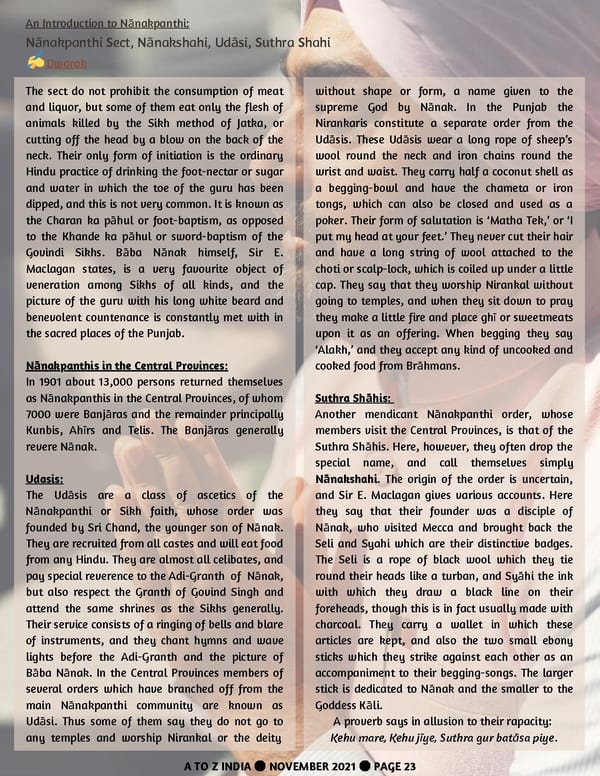An Introduction to Nānakpanthi: Nānakpanthi Sect, Nānakshahi, Udāsi, Suthra Shahi Dwarak The sect do not prohibit the consumption of meat without shape or form, a name given to the and liquor, but some of them eat only the flesh of supreme God by Nānak. In the Punjab the animals killed by the Sikh method of Jatka, or Nirankaris constitute a separate order from the cutting off the head by a blow on the back of the Udāsis. These Udāsis wear a long rope of sheep’s neck. Their only form of initiation is the ordinary wool round the neck and iron chains round the Hindu practice of drinking the foot-nectar or sugar wrist and waist. They carry half a coconut shell as and water in which the toe of the guru has been a begging-bowl and have the chameta or iron dipped, and this is not very common. It is known as tongs, which can also be closed and used as a the Charan ka pāhul or foot-baptism, as opposed poker. Their form of salutation is ‘Matha Tek,’ or ‘I to the Khande ka pāhul or sword-baptism of the put my head at your feet.’ They never cut their hair Govindi Sikhs. Bāba Nānak himself, Sir E. and have a long string of wool attached to the Maclagan states, is a very favourite object of choti or scalp-lock, which is coiled up under a little veneration among Sikhs of all kinds, and the cap. They say that they worship Nirankal without picture of the guru with his long white beard and going to temples, and when they sit down to pray benevolent countenance is constantly met with in they make a little fire and place ghī or sweetmeats the sacred places of the Punjab. upon it as an offering. When begging they say ‘Alakh,’ and they accept any kind of uncooked and Nānakpanthis in the Central Provinces: cooked food from Brāhmans. In 1901 about 13,000 persons returned themselves as Nānakpanthis in the Central Provinces, of whom Suthra Shāhis: 7000 were Banjāras and the remainder principally Another mendicant Nānakpanthi order, whose Kunbis, Ahīrs and Telis. The Banjāras generally members visit the Central Provinces, is that of the revere Nānak. Suthra Shāhis. Here, however, they often drop the special name, and call themselves simply Udasis: Nānakshahi. The origin of the order is uncertain, The Udāsis are a class of ascetics of the and Sir E. Maclagan gives various accounts. Here Nānakpanthi or Sikh faith, whose order was they say that their founder was a disciple of founded by Sri Chand, the younger son of Nānak. Nānak, who visited Mecca and brought back the They are recruited from all castes and will eat food Seli and Syahi which are their distinctive badges. from any Hindu. They are almost all celibates, and The Seli is a rope of black wool which they tie pay special reverence to the Adi-Granth of Nānak, round their heads like a turban, and Syāhi the ink but also respect the Granth of Govind Singh and with which they draw a black line on their attend the same shrines as the Sikhs generally. foreheads, though this is in fact usually made with Their service consists of a ringing of bells and blare charcoal. They carry a wallet in which these of instruments, and they chant hymns and wave articles are kept, and also the two small ebony lights before the Adi-Granth and the picture of sticks which they strike against each other as an Bāba Nānak. In the Central Provinces members of accompaniment to their begging-songs. The larger several orders which have branched off from the stick is dedicated to Nānak and the smaller to the main Nānakpanthi community are known as Goddess Kāli. Udāsi. Thus some of them say they do not go to A proverb says in allusion to their rapacity: any temples and worship Nirankal or the deity Kehu mare, Kehu jīye, Suthra gur batāsa piye. A TO Z INDIA ● NOVEMBER 2021 ● PAGE 23
 A TO Z INDIA - NOVEMBER 21 Page 22 Page 24
A TO Z INDIA - NOVEMBER 21 Page 22 Page 24